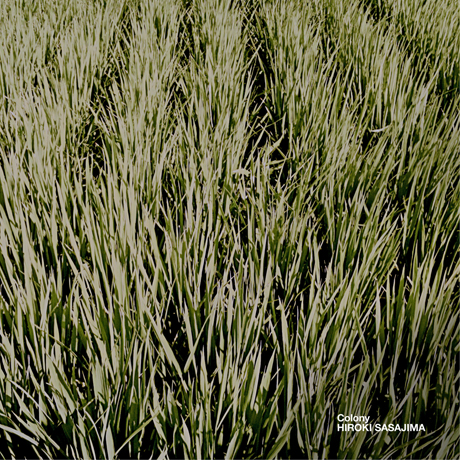
Colony
HIROKI SASAJIMA
IHab040 |
I’ve long been fascinated by the detail of sound, whether in a dense audible field or in the
quietest environment. Indeed, it is locations we think of as ‘still’ that draw me in most.
Listening to the stridulation of insects is just one way we can move nearer to the world in which small occurrences often create the loudest sonic elements. By shifting our
perception we can understand more clearly how fluid, how active stillness really is.
On ‘Colony’ Hiroki Sasajima presents us with eighteen movements; a few minutes each,
intense and strident, capturing the language within locations dominated by these
sonic elements to such an extent that it is the normal human instinct to filter them out.
One of the reasons I remain fascinated by the act of field recording, the art of listening,
is its ability to remove those filters and ‘Colony’ reminds us of that process.
-Jez Riley French
Colony is a collection of raw recordings focused on communication signals of small insects
and sounds taken from their natural habitat. Over the course of almost three years, I made
recordings at several locations at specific times of the year when the insects become most
active. Various soundscapes exist, defined by different characteristics of the small spaces
that they inhabit. Insects have an extraordinarily acute sense of hearing, and there is
documentation that they respond to a wide range of sounds and can freely adjust the level
of their hearing in accordance with the sounds of their own. Sound is the most important
component of their lives, which made it interesting to recreate the sounds of their immediate
surroundings and their signals of communication.
Colony is entirely free of artificial or man-made sounds, eliminated so that the sounds from
the insects' surroundings can be heard as clearly as possible. The actual spaces that we
human beings inhabit in everyday life, of course, are always closely connected to theirs.
From a bush in our yard, a park at a city street corner, to areas that are rural, a myriad of
communities exist in various places. In Japanese culture, appreciating the sounds of insects
is a tradition that goes back to olden times, their sounds enjoyed as songs, a voice or
a message from another creature. Many such sounds exist in the changing of the seasons
and in a delicate natural environment, certain to keep stimulating our own sensibility.
-Hiroki Sasajima |
| 00. |
Complete package (Artwork + Mp3 Sound files) |
(ZIP) |
75,0Mb |
DOWNLOAD |
| 00. |
Complete package (Artwork + FLAC Sound files) |
(ZIP) |
200Mb |
DOWNLOAD |
I rarely come across an audio publication that dedicates its content to the sounds of insects, so for me ‘Colony’ was like a breath of fresh air. Hiroki Sasajima spent three years recording insects in a range of locations and this final compilation demonstrates both his technical ability and acute sensitivity as a recordist to his acoustic environment.
Each recording possesses its own signature sound and there is much variety between tracks, which keeps the listening experience fresh and engaging. Hearing the insects in the context of their immediate surroundings is another reason why ‘Colony’ works so well. The background of each recording provides an essential layer to the soundscape and helps create the overall atmosphere.
At times the sounds are incredibly intense and one can only imagine what it must be like to experience this in the field. The energy contained within these signals is almost tangible and you can’t help but admire the endurance and sonic power of these small creatures.
‘Colony’ also exposes the listener to the natural rhythms of insect communication. When thinking of musicality in nature, most would automatically turn their thoughts to birdsong, but other animal groups, especially insects and amphibians, also demonstrate a high degree of regularity and rhythm.
There is no information on the species featured in these recordings, which leads me to wonder how Sasajima approached the project. Did he compile a checklist of “star” insects that were gradually tracked down? Or was he simply inspired by the sounds he heard and decided to record them purely on the merits of their interest, structure and relationship with the surrounding environment? I may be wrong but I get the feeling that it’s the latter.
This collection of field recordings is a wonderful homage to the complexity and beauty of sound communication in insects. Sasajima has an innate affinity with the natural world and successfully uses sound as a medium for sharing his obvious love for natural environments. ‘Colony’ is another fine example of this longstanding relationship and comes highly recommended.
-Cheryl Tipp (from The Field Reporter) |
|
COPYLEFT:
artwork/cover design:
©2012 Hiroki Sasajima
©2012 David Vélez
music:
©2012 Hiroki Sasajima
©2012 Impulsive Habitat
This work is licensed under a BY-NC-SA 3.0
Creative
Commons License.
HOW TO DOWNLOAD MUSIC TRACKS:
- right click the individual links
to the files;
- choose 'save as' and
point it to the place of your preference (eg:
your 'desktop');
- single click usually
works, too.
HOW TO PLAY MUSIC TRACKS:
- choose an appropriate mp3/flac player
(we recommend Winamp)
and install it on your system;
- usually,
you double click the music files to play them,
but you might want to follow the program's specific
instructions.
|
|

